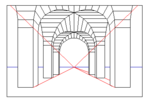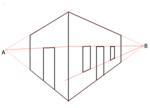Vanishing point

In graphical perspective, a vanishing point is a point in the picture plane π that is the intersection of the projections (or drawings) of a set of parallel lines in space on to the picture plane. When the set of parallels is perpendicular to the picture plane, the construction is known as one-point perspective and their vanishing point corresponds to the oculus or eye point O from which the image should be viewed for correct perspective geometry.[1] Traditional linear drawings use objects with one to three sets of parallels, defining one to three vanishing points.
Theorem
The vanishing point theorem is the principal theorem in the science of perspective. It says that the image in a picture plane π of a line L in space, not parallel to the picture, is determined by its intersection with π and its vanishing point. Some authors have used the phrase, "the image of a line includes its vanishing point". Guidobaldo del Monte gave several verifications, and Humphry Ditton called the result the "main and Great Proposition".[2] Brook Taylor wrote the first book in English on perspective in 1714, which introduced the term "vanishing point" and was the first to fully explain the geometry of multipoint perspective, and historian Kirsti Andersen compiled these observations[3] She notes, in terms of projective geometry, the vanishing point is the image of the point at infinity associated with L, as the sightline from O through the vanishing point is parallel to L.
Vanishing line
As a vanishing point originates in a line, so a vanishing line originates in a plane α that is not parallel to the picture π. Given the eye point O, and β the plane parallel to α and lying on O, then the vanishing line of α is β ∩ π. For example, when α = π = ground plane, then β is the horizon plane with β ∩ π the horizon line.[4]
Curvilinear and reverse perspective
A curvilinear perspective is a drawing with either 4 or 5 vanishing points, in 5-point perspective the vanishing points are mapped into a circle with 4 vanishing points at the cardinal headings N,W,S,E and one at the circle origin.
A reverse perspective is a drawing with vanishing points that are placed outside the painting with the illusion that they are "in front of" the painting.
-
One-point perspective projection.
-
Pietro Perugino's usage of perspective in the Delivery of the Keys fresco at the Sistine Chapel (1481–82) helped bring the Renaissance to Rome.
-
An example of perspective using two vanishing points.
See also
References
External links
- Geometry of the Vanishing Point at Convergence
- Trigonometric Calculation of Vanishing Points Brief explanation of the rationale with an easy example
- A tutorial covering many examples of linear perspective



